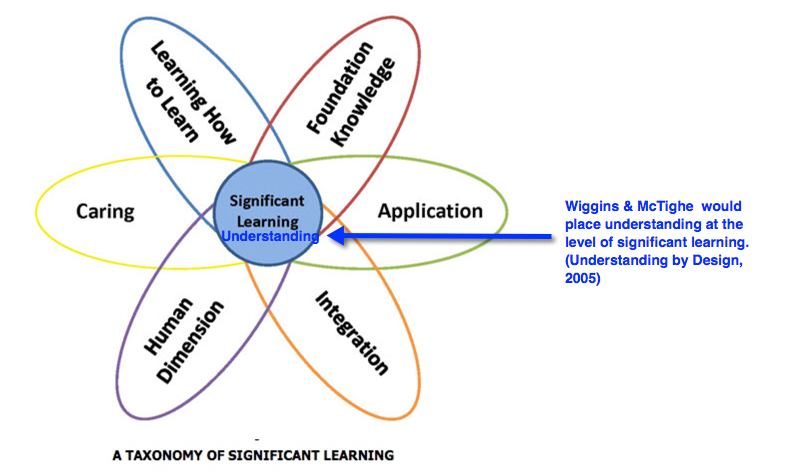Course:CTLT Course Design Intensive/UbD Principles/Learning Plan
Backwards Design
Key features:
- work backward from your goals, intentions and high level learning objectives to learning activities and assessment that support.
- alignment between goals, activities and assessment
- focus is on enduring understanding
Goals
Understanding
- Form follows function. How might this be an organizing principle related to course design?
Performance
Proposed learning objectives for the session:
- Discuss "form follows function" as an organizing principle in course design.
- Analyze (at a surface level) taxonomies for learning and how they might inform course design decisions. (Bloom's, Fink's and Wiggins & McTighe)
- Apply backward design process to a selection of your course goals in order to:
- prioritize goals for enduring understanding (Stage 1)
- align course goals with suitable assessment (Stage 2)
- prepare for activity planning (Stage 3)
Evidence
- Core values exercise: develop a goal reflecting core/enduring understanding surfaced/refined.
- Surface analysis of taxonomies: linking observations with innovative teaching practices and requirements of the learner.
- Application of backward design process: at least one goal aligned with suitable assessment - to serve as a prototype
Learning Activities
Pre-Session Activity
- Video: Backward Design Process
- Discussion questions: How does the backward design process relate to the larger, universal design principle: form follows function?
Bridge In Activity
- Group discussion: ask groups to identify 2-3 ways in which backwards design intersects the more universal design principle "form follows function." Or maybe you see something different - about form and function - discuss. 5 min. Debrief. 5. TIME 10 min.
Activity 1: Personal Reflection
Why? : sometimes a response to a scenario engages us at an emotional level that can help uncover values in a way that questions can't.
Imagine it is two years from now and you've run into one of your students who had taken your class this year. He's telling you that the most important thing he learned in your class was X.
What do you hope the X is? Try to give an immediate response. Think about the ideal qualities, attitudes, beliefs, knowledge, skills that they might possess. Write it down.
If you did this as part of the pre-workshop reflection, did your response change since Monday? If this is the first time you've reflected on this, does your response match with any of the goals you have defined for your course so far? If not, you may want to examine why - it could form the basis for a learning goal that reflects enduring understanding.
Activity 2: Individual: Application of Backward Design Process to Course Goals
3 Stage Activity
Stage 1: Prioritizing
Enduring Understanding: Review of the 3 stage process and purpose - to support understanding - particularly what is called "understanding'. TIME: 10 min: 5 minutes groups/ 5 min popcorn debrief
- * Filters for Enduring Understanding
- * Group Discussion: Identify at 1 or 2 examples of enduring understandings relative to the courses/disciplines represented at your table.
Sample Course Goal: Enduring Understanding:

http://sites.davidson.edu/hacking/course-guidelines/
Prioritizing Your Goals: Work with your goals (as they are so far) and the prioritizing framework to identify at least one goal in each area. TIME: 10 min
- * Prioritzing Framework -
- From your course goals - identify one for each area of priority. Why? Because everything is not equal in importance. This will lead into a demonstration of selecting "evidence" or assessment methods.
- * Prioritzing Framework -
Stage 2: Aligning
Assessment/Alignment . File:Course Design Intensive Session 3 Assessment.pptx: TIME: 30 min.
- good/bad assessments (small groups): What makes learning assessment good or bad?
- criteria for good assessment
- Slides (examples)
- group activity: develop 1-2 assessments to align with sample learning objectives?
Assessment/Evidence Alignment THINK, PAIR, SHARE: TIME: 20 min. 10 min to associate/ 10 min to partner/no debrief.
- Think: Associate evidence/assessment method for at least one of your selected course goals in each area of priority.
- Pair up and share one with partner. Partner's job is to ask questions to ensure alignment between goal and assessment. After 5 mins - switch.
Stage 3: Refining
Three column Course Design format: Begin to think about learning activities/steps to align with goals and assessment. Take 10 min to refine and transfer what you have done so far. You will take this into your work for tomorrow. If yu have sketches of ideas - fine - you can do more refining tomorrow.
Activity 3: Group: Taxonomies of Learning Informing Design Decisions
Why?: We've referenced various learning taxonomies through the session because they help support our developing understanding of learning and help guide our decisions. They might also help to guide us in thinking about the kind of learning that some new pedagogical approaches are trying to foster.
Your goal - in small groups: to examine (at a surface level) 3 learning taxonomies and how they may support decision making related to design of learning environments.
- Compare/contrast taxonomies for learning (Fink, Wiggins/McTighe, Blooms) (group) Share observations within your group.
- Consider new pedagogical approaches in terms of what may be expected of learners in those environments. Draw on the taxonomies to support your decisions about how you might use the above approaches in your learning environment.
Resources:
Handouts
- Template for Understanding by Design Planning ( could be useful?)
- Enduring Understanding
- Prioritzing Framework
- Assessment plus Prioritizing Framework
- Assessment Methods: Eberley Centre: CMU
- 3 Column Planning Worksheet
- Examples
- 6 Facets of Understanding - Rubric
Video
- Backward Design Process
- Backwards Brain Bicycle: brilliantly demonstrates something about unlearning (which may be important in dealing with misconceptions and cognitive bias

